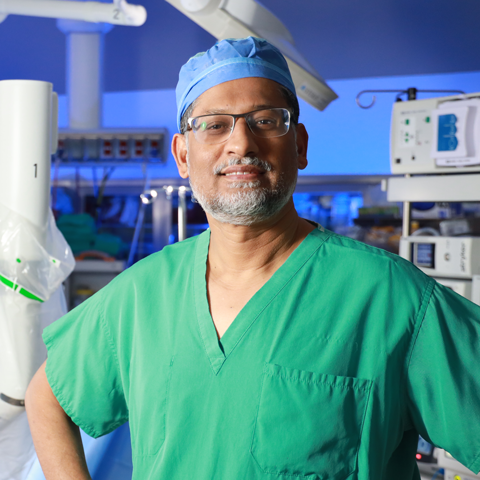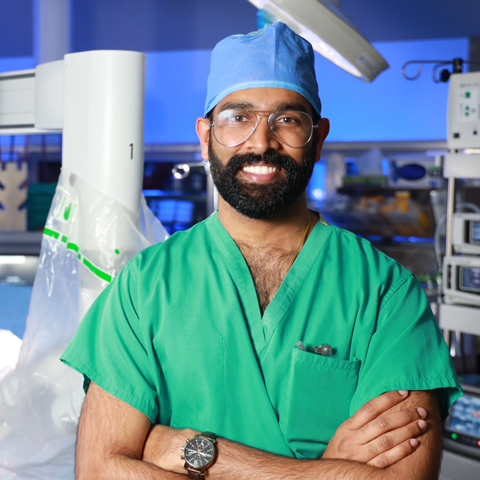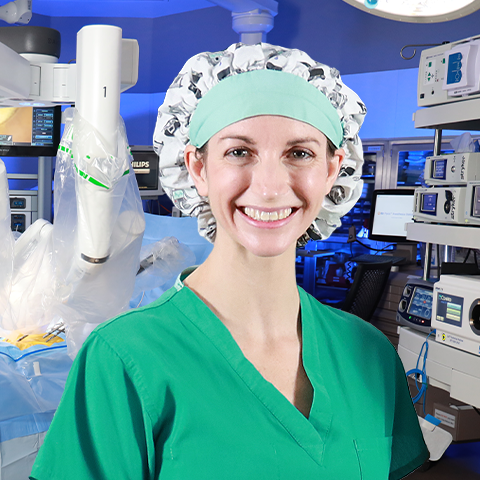Hannibal Regional Healthcare System is dedicated to guiding our patients to BETTER. Many options exist for patients who are seeking a better quality of life through surgical intervention, which is why Hannibal Regional continues to invest in the latest surgical technology including the da Vinci Xi Robot.
Hannibal Regional’s Robotic Surgery program offers the opportunity for specially trained surgeons to perform a wide range of delicate and complex surgeries through a minimally invasive technique. Traditional open surgery requires a large incision while a less invasive approach, such as robotic-assisted surgery requires a smaller incision and has a quick recovery time. Hannibal Regional offers robotic-assisted surgery for a variety of gynecological surgery, general surgery, bariatric surgery, and urological surgery procedures.
How Hannibal Regional is guiding you to BETTER through technology and innovation:
The da Vinci XI surgical system at Hannibal Regional provides your surgeon with three main advantages while remaining 100% in control throughout the entire surgery: superior visualization, enhanced dexterity, and greater precision.
Visualization
Enhanced visualization is possible because of the optics within the surgeon console and endoscope. Together they provide the surgeon with a highly magnified three-dimensional high-definition (3DHD) image. With this enhanced visualization and accurate depth perception, the surgeon can see clearer anatomical planes and structures.
Dexterity
The EndoWrist technology enables surgeons to have fully wristed dexterity with a minimally invasive approach. These wristed robotic instruments were inspired and designed to mimic the human hand, but offer a greater range of motion enabling surgeon precision.
Precision
The system seamlessly adjusts hand-to-instrument ratios, and tremor reduction further enhances the fingertip control. The stable ergonomic platform in the system virtually eliminates physiologic tremor. This along with the advanced visualization and dexterity of the wristed instruments, surgeons are able to reach intricate areas without the need to manipulate large areas of surrounding tissue. This provides the surgeon with greater precision, flexibility, and control.
How are we guiding you to BETTER?
Our goal is to guide you to BETTER faster with advanced technology and innovation by offering minimally invasive procedures. The da Vinci surgical system offers greater visualization and instruments acting as an extension to the surgeon’s arms allowing them to access smaller areas without manipulating or disturbing surrounding tissue. This approach helps our patients have shorter hospitalizations, reduced pain, minimize the need for pain medication, faster recovery time, reduced risk of infection, less blood loss, and minimal scarring.
Robotic-Assisted Procedures at Hannibal Regional
All robotic surgeries are performed by creating small incisions in the abdomen. Ports, which are similar to small tubes, are placed at each incision. The robot arms are connected to each port, and the instruments and camera are inserted. The surgeon will move to the console which allows them to have full control of the camera and instruments.
Gynecological Procedures
- Hysterectomies: A hysterectomy is the surgical removal of the uterus. Reasons for this surgery include abnormal bleeding, uterine prolapse, fibroids, and cancer. Before your procedure, your surgeon will discuss which type of hysterectomy is most appropriate depending on your condition. A robotic-assisted hysterectomy allows the surgeon to perform the procedure through tiny incisions on the abdomen. Because of this, robotic hysterectomy patients typically enjoy a shorter recovery period than women who undergo a traditional approach.
General Surgery
- Robotic Assisted Hernia Repairs: a hernia occurs when an internal organ pushes through a weak spot in your muscle or tissue. The most common types of hernia are inguinal (inner groin), incisional (resulting from an incision), femoral (outer groin), umbilical (belly button), and hiatal (upper stomach). If you think you have a hernia, don’t wait to seek help. Hernias usually do not get better on your own and your doctor will recommend the best treatment for you and may refer you to a surgeon. After meeting with you the surgeon will discuss your option for repairing the hernia. Some advantages of robotic hernia surgery are that the patient has tiny scars rather than one large incision scar, and there may be less pain after this surgery compared to open surgery.
- Robotic-Assisted Cholecystectomy: a cholecystectomy is the surgical removal of the gallbladder. Patients with a problematic, dysfunctional gall bladder (i.e. gallstones, inflammation, polyps) may experience pain, nausea, or vomiting, which are indicators it may need to be removed. A robotic-assisted cholecystectomy allows patients to have their gallbladders removed using a minimally invasive approach resulting in minimal pain, less blood loss, quick recovery, and most patients go home the same day.
Urological Surgery
- Prostatectomy: a prostatectomy is a procedure to remove part or all of the prostate gland. With an open approach, men were concerned about the possibility of incontinence or sexual dysfunction after surgery. Utilizing the da Vinci robotic surgery system offers surgeons a three-dimensional, high-definition magnified image that allows for the identification of surrounding structures and muscles, greatly reducing the risk of damage to those areas. The prostate is removed through one of the small incisions in the abdomen.
- Kidneys: Surgical removal of all or part of the kidney is the standard of care for patients with renal tumors. Choosing a minimally invasive approach decreases the risk of complications while allowing the patient’s to have less pain and a faster recovery.
Total Knee Replacement
- Total Knee Replacement: Mako SmartRobotics™ for total knee replacement is a treatment option designed to relieve the pain caused by joint degeneration due to osteoarthritis. The Mako robotic arm is used for total knee replacements and is designed to give surgeons a more predictable surgical experience with increased precision and accuracy. Using a robotic arm, Mako allows for a more precise procedure, tailored to each patient’s anatomy through a 3D CT scan.
Our Robotic Surgeons
Click on the picture for more details.

Mujeeb Siddiqui, DO, FACOS, FASMBS
Bariatrics
Read More

Mujeeb Siddiqui, DO, FACOS, FASMBS
Bariatrics
"There are many benefits to having a Robotic-assisted surgery. I like Robotic-assisted surgery because it benefits patients directly—shorter recovery time—as well as indirectly—the surgeon has better visualization, leading to a more precise surgery. Other benefits of Robotic surgery are that it allows me to have a greater range of motion and dexterity, a highly-magnified and high-resolution image of the operating field. This translates into shorter hospital stays, less risk of infection, less blood loss, less pain, faster recovery, and quicker return to daily routine."
Learn More About Dr. Siddiqui

Richie Goriparthi, MD, MSc
General and Bariatric Surgery
Read More

Richie Goriparthi, MD, MSc
General and Bariatric Surgery
“Robotic surgery had taken the minimally invasive surgery to the next level. We can perform complex procedures with much ease with the robot. It offers better visualization and dexterity that translates to shorter procedure times and the overall improved quality of the operation. Patients also experience less pain and need fewer narcotics, enhancing their overall recovery!”
Learn More About Dr. Goriparthi

Jennifer Roberts, DO, MS
OB/GYN, Medical Director - Robotics
Read More

Jennifer Roberts, DO, MS
OB/GYN, Medical Director - Robotics
“Surgeons can perform procedures that would otherwise require larger incisions leading to less postoperative pain and quicker recovery times,” shares Dr. Roberts. “Hysterectomies that would otherwise require an incision similar to that of a C-section or a larger vertical incision can be completed with a minimally invasive technique and only require small incisions. The majority of hysterectomy patients who chose to have robotic assisted surgery have been able to go home the same day with minimal need for pain medication.”
Learn More About Dr. Roberts